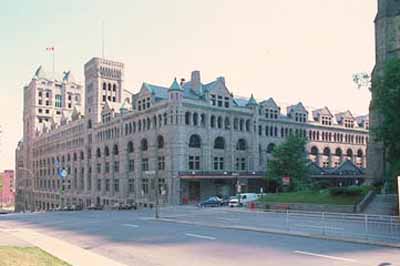Windsor Station (Canadian Pacific) National Historic Site of Canada
Montréal, Quebec

General view of Windsor Station (1990)
(© Parks Canada Agency/Agence Parcs Canada)
Address :
1100 Peel Street, Montréal, Quebec
Recognition Statute:
Historic Sites and Monuments Act (R.S.C., 1985, c. H-4)
Designation Date:
1975-11-28
Dates:
-
1888 to 1889
(Construction)
-
1900 to 1906
(Addition)
-
1909 to 1914
(Other addition)
Event, Person, Organization:
-
Bruce Price
(Architect)
-
Edward Maxwell
(Architect)
-
W. S. Painter
(Architect)
Other Name(s):
-
Windsor Station (Canadian Pacific)
(Designation Name)
-
Windsor Station
(Other Name)
Research Report Number:
May 1971-G, RSR-014
Plaque(s)
When it opened in 1889, the grand scale and solid appearance of this train station conveyed the confidence of Canadian Pacific, builder of the country’s first transcontinental railway, which established its headquarters here. President William C. Van Horne retained American architect Bruce Price to design Windsor Station and other Canadian Pacific landmarks, including the Château Frontenac hotel. Early-20th-century additions were seamlessly integrated into the original Romanesque Revival design, with its rusticated stonework, round-arched arcades, and a steeply pitched roof with towers, turrets, and protruding gables.
Description of Historic Place
Windsor Station is a late 19th-century, stone railway terminal and Canadian Pacific Railway (CPR) head office built in the Romanesque Revival style. It is prominently located at the corner of Canada Place in downtown Montréal. The formal recognition consists of the building on its footprint at the time of designation.
Heritage Value
Windsor Station was designated a national historic site in 1975 because it is an excellent example of the Romanesque Revival style of architecture.
Built for the CPR in 1888-89 to designs by American architect Bruce Price, Windsor Station was one of the earliest major buildings in Canada to use the Richardsonian Romanesque Revival style. The original portion by Price set the style for the structure and for the principal additions made in 1900-06, to designs by Edward Maxwell, and in 1909-14 to designs by W.S. Painter. The additions are compatible with the original design, reinforce its Romanesque Revival character and establish bridges between the Romanesque Revival and the Château Style of later CPR buildings.
Sources: Historic Sites and Monuments Board of Canada, Minutes, June 1975; Commemorative Integrity Statement, 1990.
Character-Defining Elements
Character-Defining Elements that relate to the heritage value of Windsor Station include:
its Romanesque Revival style, expressed in the dramatic rhythm created by wide-arched openings, steeply pitched roofs, prominent gables, towers, turrets, prominent string courses and arched open-loggia openings along the top floor, the deeply-set and vertically grouped windows, wide-arched bays supported by colonnettes, and the high quality, but restrained sculptural details of floral and animal motifs, executed in a sinuous style; the solid, rustic appearance of the building created by the use of Montréal limestone on exterior elevations, the large size and rock-faced finish of the limestone units, and the overall Romanesque Revival design and detailing; the roofline of the 1909-14 addition, reflecting the way in which Romanesque Revival and Château-style elements were blended together over time; surviving original volumes, materials and detailing of the main ticket lobby; the covered carriage way along the north elevation of the 1900-06 wing; remnants of the original De La Gauchetière Street entrance to the building, evident in the exterior and interior fabric and features.